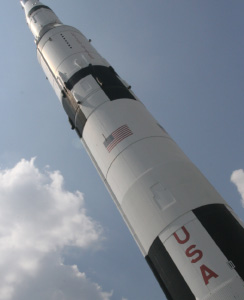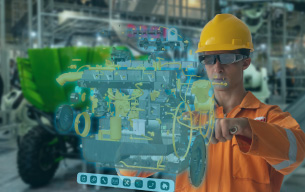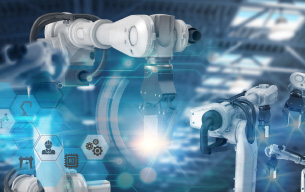Unlocking the Power
of Digital Twins
Revolutionizing Network Optimization
Digital Twins in Network Design
Telecom companies are using digital twins to minimize risk and optimize network
performance by creating a virtual replica of physical assets or systems.
Minimizing Risk of failure with Digital
Twin Simulations
Digital twins help telecom operators test various configurations and settings before implementation, reducing the likelihood of costly errors or system failures.
Real-time Data Capture for Informed Decision-making
This eBook revisits the state of 5G in the enterprise marketplace, with a focus on indoor/on-campus environments. It examines the broader impact of business, society and technological changes on industry other iBwave documents and webinars. It also does not discuss spectrum bands, again detailed elsewhere.
Digital twins provide valuable insights into infrastructure performance through advanced sensors and artificial intelligence algorithms.
For example, data collected from a digital representation of an antenna system can help engineers determine the optimal positioning and configuration for maximum signal coverage.
Similarly, AI-powered analytics applied to real-time network traffic data enable operators to identify trends and adjust accordingly.
By analyzing usage patterns on digital twin models, service providers can tailor their offerings more effectively while identifying new revenue streams or market opportunities.
Utilizing digital twin technology in network design not only helps minimize risk but also ensures that telecommunications companies remain agile and responsive in an ever-changing landscape.
As IoT devices continue to proliferate and demand for wireless connectivity grows exponentially, leveraging virtual replicas will be key for maintaining competitive advantage in the years ahead.

The Evolution of Digital Twin Technology
Thanks to IoT, AI, and cloud computing, digital twin technology has come a long way.
Historical Overview of Digital Twin Concepts

Digital twins have been around for decades. Years before the term ‘digital twin’ was coined, NASA’s solution for fixing the damaged Apollo 13 spacecraft was one of the earliest examples of a digital twin being used. General Electric introduced them into industrial applications in the early 2000s.
Today, digital twins are highly accurate virtual replicas of physical assets or systems, making them essential tools for network design and optimization in various sectors, including telecommunications.
It’s more useful to think of three broad phases for 5G, with different implications for enterprises looking to exploit and deploy it:
Tools like iBwave Design offer innovative indoor wireless solutions serving over 1,000 leading telecommunication companies worldwide, making it easier than ever to optimize networks using digital twin technology.
Data Sharing with Partners & Suppliers
Successful implementation of digital twin technology requires seamless data sharing with partners and suppliers in the telecom sector.
Importance of seamless data sharing among stakeholders
Accurate and timely data is essential for staying ahead in the competitive telecom industry.
Digital twins provide a single source-of-truth by creating virtual replicas of real-world systems and environments.
Sharing these models among partners and suppliers enables effective collaboration on various aspects such as network planning, optimization, and troubleshooting issues.
Standardized formats and protocols for exchanging information between different software tools used by various stakeholders are necessary for achieving seamless data sharing.
iBwave offers an end-to-end solution for designing in-building wireless networks using digital twin technology while ensuring interoperability with other platforms through open APIs.
Collaboration Benefits from Shared Access to a Single Source-of-Truth
Digital twin technology promotes transparency among stakeholders, particularly when working on large-scale projects involving multiple parties who need to trust each other’s contributions.
By harnessing the shared access to precise information facilitated by iBwave solutions and virtual replicas, organizations can elevate their collaboration efficiency and achieve groundbreaking outcomes through innovation.

In-Building Private Networks & Telecom Industry Relevance
As demand for seamless connectivity grows, in-building private networks are increasingly important in the telecom industry. Digital twin technology plays a crucial role in creating virtual replicas that optimize network performance and reduce costs.
Use Cases for Deploying Private Networks Using a Virtual Replica
Cost-saving Potential Through Improved Network Optimization
Digital twin technology streamlines network design and deployment processes, resulting in reduced time-to-market, better resource allocation, and improved network performance.
As more industries embrace digital transformation initiatives like IoT and AI, it is crucial that telecommunication networks keep pace with these advancements. The adoption of digital twin technology offers significant opportunities for improved efficiency, cost savings, and better collaboration among stakeholders involved in designing telecommunications infrastructure using solutions like iBwave’s wireless design tools.
Key Takeaway:
Digital twin technology is becoming increasingly important in the telecom industry, as it allows for virtual replicas that optimize network performance and reduce costs. This technology can be applied to various industries such as smart buildings, healthcare facilities, airports, and sports venues to streamline network design and deployment processes resulting in reduced time-to-market, better resource allocation, and improved network performance.

Revolutionizing Product Development & Infrastructure Design
Digital twins are improving product development and infrastructure design in the telecom industry, allowing engineers to simulate scenarios, test ideas, and optimize designs before implementation, reducing costs and accelerating time-to-market.
Accelerating Time-to-Market with Digital Twins
Digital twin technology enables organizations to iterate on designs more rapidly, bringing innovative solutions to market faster while minimizing risks associated with traditional trial-and-error methods.
Fostering Collaboration through Shared Access
Digital twins allow multiple stakeholders access to accurate information, promoting collaboration among teams working on different aspects of product development or infrastructure design projects within the telecom sector.
Real-World Applications of Digital Twins in Telecom
Verizon’s digital twin project uses virtual replicas of its physical assets to analyze network performance under different conditions. Nokia’s Digital Twin as a Service (DTaaS) provides operators with an accurate representation of their networks for planning purposes.
The growing adoption of digital twins within the telecommunications industry demonstrates how these innovative tools are transforming traditional approaches to product development and infrastructure design, leading to greater efficiency and collaboration across the sector.
FAQs about Digital Twins in Network Design

What is a digital twin in telecommunications network design?
A digital twin in telecommunications network design is a virtual replica of a network infrastructure that allows engineers to simulate, analyze, and optimize the system, reducing costs and improving overall network performance.
What are the key concepts of digital twins?
Three key concepts of digital twins are physical-to-digital connection, real-time data processing, and the physical-to-digital feedback loop.
· Physical-to-Digital Connection revolves around establishing a seamless connection between the physical world and its digital representation. It involves creating a virtual counterpart (the digital twin) of a physical object, system, or process. This is achieved through the integration of various data sources such as sensors, IoT devices, and other data-capturing mechanisms that continuously monitor and collect real-world information. By creating this link, organizations can gain deeper insights into the behavior and performance of the physical asset, allowing for better analysis, optimization, and decision-making.
· Real-time Data Processing. As data is collected from the physical asset, it is transmitted to the digital twin. This data processing can occur in real-time, enabling immediate visualization, analysis, and assessment of the physical asset’s current state. Through advanced analytics and machine learning algorithms, patterns, trends, and anomalies can be identified, leading to predictive and prescriptive insights. Real-time data processing empowers organizations to make proactive decisions, anticipate issues, and respond swiftly to changes or potential problems.
· Digital-to-Physical Feedback Loop. The insights and knowledge generated from the digital twin can be translated into actions that impact the physical asset. This feedback loop allows organizations to implement changes, optimizations, or improvements in the physical world based on the findings and simulations performed on the digital twin. It enables a closed-loop system where real-world data drives improvements and refinements in the digital realm, and vice versa. This iterative process helps enhance the performance, efficiency, and overall effectiveness of the physical asset or system. processing, and Digital-to-Physical feedback loop.
What are the benefits of digital twins in network design?
Benefits include the ability to identify potential problems before they occur, the ability to optimize network performance and reduce costs, and the ability to quickly respond to customer demands.
Additionally, digital twins allow telecom companies to gain valuable insights into customer behavior and preferences. This data can be used to develop new products and services that are tailored to customers’ needs.
Which technologies are used in digital twins?
Modern digital twins use IoT, AI, cloud computing, machine learning algorithms, big data analytics platforms like IBM Watson Studio, advanced visualization tools, and network design software like iBwave.
How has digital twin technology impacted the telecommunications industry?
Digital twin technology has transformed industries by minimizing risks associated with design changes or new implementations while optimizing resource utilization, improving network planning accuracy, reducing deployment timeframes & operating expenses, and enhancing user experience.
Digital twin technology has enabled industries to optimize their operations by providing real-time insights into the performance of their systems. This has allowed them to quickly identify and fix any issues without having to spend time and resources on manual troubleshooting. Additionally, digital twins can be used to simulate future scenarios, allowing companies to test out new strategies and products before implementing them.
Digital twin technology has also allowed companies to improve their customer service by providing personalized experiences. This has enabled telecom companies to gain valuable insights into customer behavior and preferences, allowing them to develop new products and services that meet customer needs. Furthermore, digital twins have improved network planning accuracy by providing detailed information on network performance and usage, allowing companies to maximize their resources and minimize operational costs.
Conclusion
Optimize network design, minimize risk of failure, and make informed decisions in real-time with digital twin technology.
By incorporating IoT, AI, and cloud computing technologies into modern digital twins, telecom companies can share data seamlessly among stakeholders for improved collaboration benefits.
Deploying private networks using a virtual replica model offers cost-saving potential through improved network optimization.
CTOs can leverage digital twin technology to improve network efficiency and reduce downtime.
In addition, digital twin technology can help telecom companies to identify potential areas of improvement, detect anomalies, and perform predictive analysis. This data can be further used to make more informed decisions and improve customer experience. Using digital twin technology can also help telecom companies to reduce their operational costs.
It can provide a tremendous amount of data and insights to help telecom companies make more informed decisions and create innovative solutions. Digital twin technology can help telecom companies revolutionize their operational processes and bring them up to the latest operational standards. Using digital twin technology can also enable telecom companies to respond quickly to changes in the market and create new opportunities.
To learn more about using digital twins in your network designs contact iBwave today.



